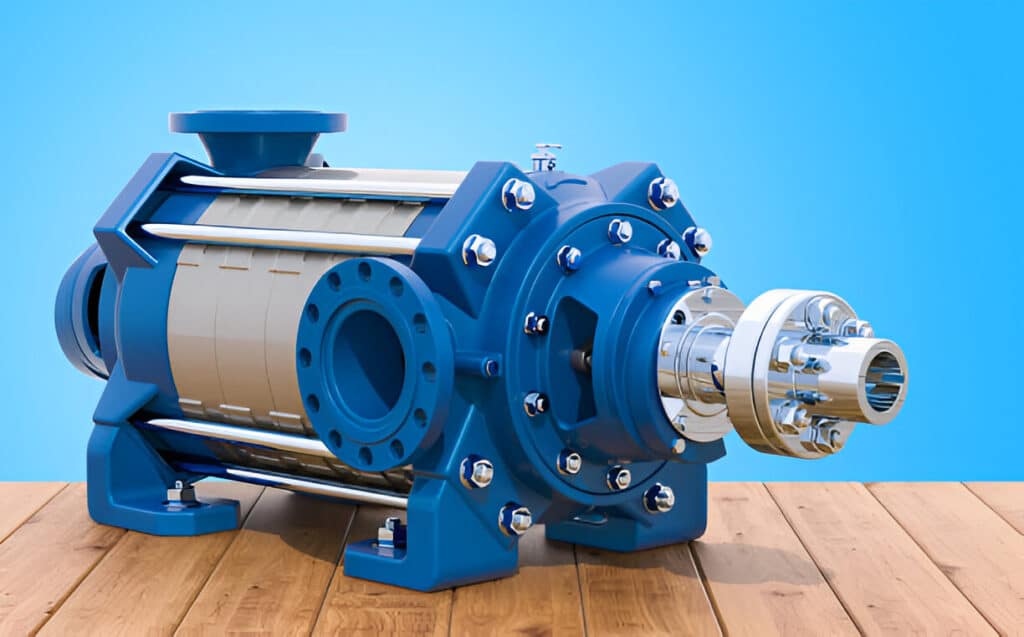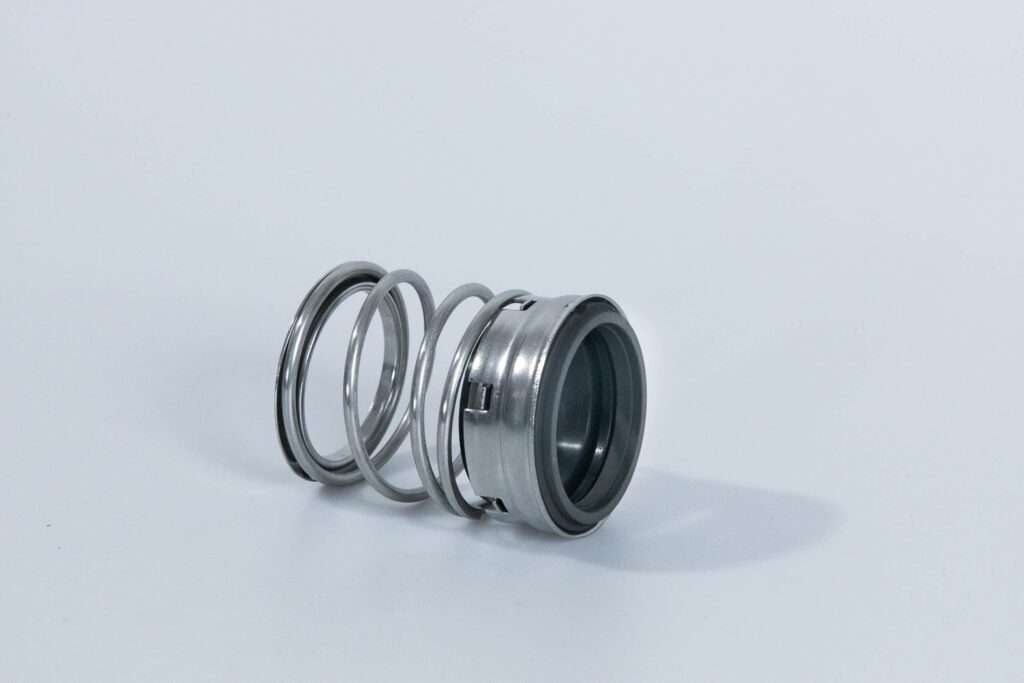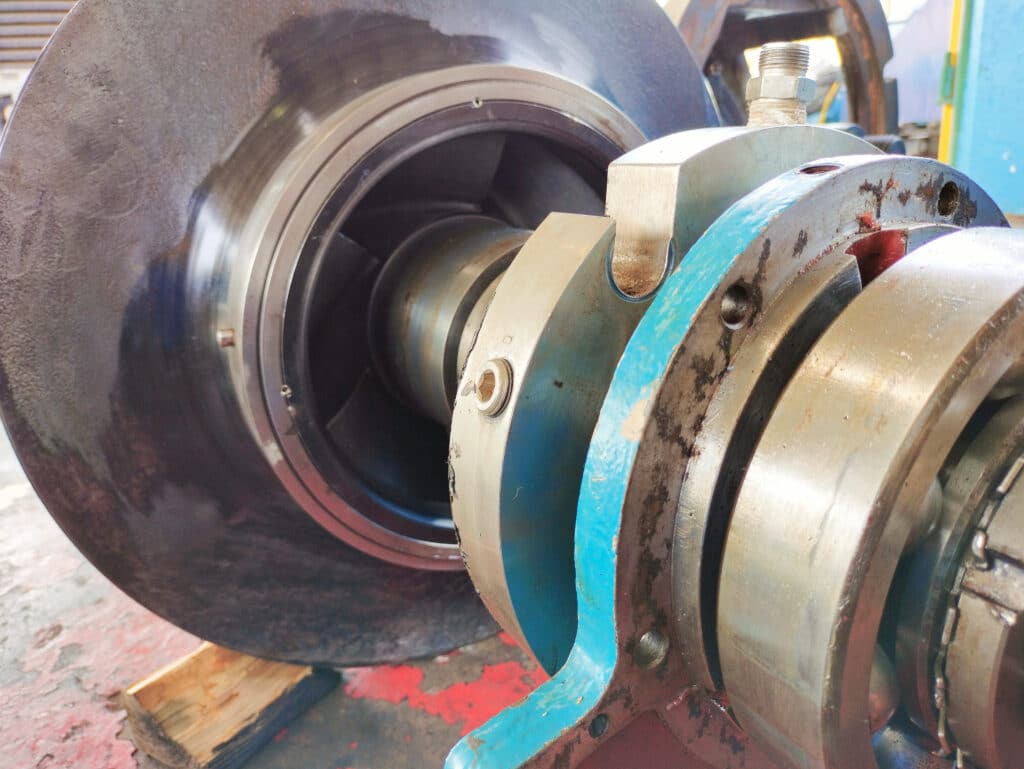
Step 1. Cut the Power
Before beginning any maintenance on a centrifugal pump, lock out and tag the power supply to prevent accidental startup during the mechanical seal installation process. Verify that the pump is completely isolated from all power sources, including any backup or emergency power systems.
Step 2. Isolate the Fluid from the Pump
Close the inlet and outlet shut-off valves to isolate the pump from the system.
If the pump lacks isolation valves, you may need to drain the entire system. Place a catch basin under the pump to collect any residual fluid that may leak during the seal replacement process. Take appropriate safety precautions when handling hazardous fluids.
Step 3. Disconnect the Centrifugal Pump
Disconnect the centrifugal pump from the motor and any outlet piping.
For close-coupled pumps, remove the motor bolts and carefully separate the motor from the pump. For frame-mounted pumps, disconnect the coupling between the pump shaft and motor shaft.
Step 4. Remove the Impeller
Carefully remove the impeller from the pump shaft. The exact process may vary depending on the specific pump model and design.
Typically, this involves removing the impeller bolt or nut and any additional hardware securing the impeller to the shaft. Use the appropriate tools, such as a 9/16-inch wrench or 3/32-inch Allen wrench, to loosen and remove the impeller.
Step 5. Detach the Seal
With the impeller removed, you can now access the mechanical seal assembly.
Remove the seal plate or gland bolts to detach the seal from the pump housing. Take note of the orientation and arrangement of the seal components, including the stationary seal, rotary seal, and any secondary seals or compression rings. Carefully remove the old seal components from the pump shaft and seal chamber bore.
Step 6. Replace the Seal
Clean the seal chamber bore, pump shaft, and any mating surfaces to ensure proper sealing.
Install the new mechanical seal components, following the manufacturer’s instructions for the specific seal model. Lubricate O-rings or rubber washers with a compatible lubricant. Ensure that the stationary and rotary components are properly aligned and seated in the seal plate bore and on the pump shaft, respectively.
Step 7. Install the Impeller
Reinstall the impeller onto the pump shaft, ensuring that it is properly aligned and seated.
Replace any compression rings, Ceramic wear rings, or metal push rings in their original positions. Secure the impeller with the impeller bolt or nut, tightening it to the manufacturer’s specified torque value. Verify that the impeller rotates freely without binding or excessive clearance.
Step 8. Reconnect the Pump
Reconnect the centrifugal pump to the motor and outlet piping.
For close-coupled pumps, carefully align the motor and pump shafts before securing the motor bolts. For frame-mounted pumps, reinstall the coupling and ensure proper alignment between the pump and motor shafts. Reconnect any auxiliary components, such as seals, gaskets, or flanges, and tighten all fasteners to the appropriate torque values.
Step 9. Restart the Machine
Open the inlet and outlet isolation valves to allow fluid to enter the pump. Double-check that all connections are secure and leak-free. Reconnect the power supply and start the motor, observing the pump for any unusual noises, vibrations, or leaks. Monitor the pump’s performance over the initial operating period to ensure that the mechanical seal is functioning correctly and the pump is operating within its designed parameters.

FAQs
What Is the Problem with Mechanical Seals in Pumps?
Common causes of seal failure include improper installation, misalignment, inadequate lubrication, and exposure to abrasive or corrosive fluids.
What Type of Shaft Seals Are Fitted on Centrifugal Pumps?
Common types of mechanical seals used in centrifugal pumps include single, double, and cartridge seals.
Can You Reuse a Mechanical Seal?
Mechanical seals are generally not recommended for reuse. Seals are precision components that wear during operation. Reusing a seal can lead to premature failure, leakage, and equipment damage.
Can You Touch a Mechanical Seal?
Avoid touching the sealing faces of a mechanical seal. Contaminants from fingers can damage the precise finish, leading to leakage. Handle seals by the outer edges only. Wear clean, lint-free gloves when handling seals during installation or maintenance. Protect sealing faces from scratches or impacts to maintain seal integrity.
Can You Clean a Mechanical Seal?
Yes, mechanical seals can be cleaned. First, disassemble the seal and remove any debris. Clean the seal faces with a soft cloth and denatured alcohol.





